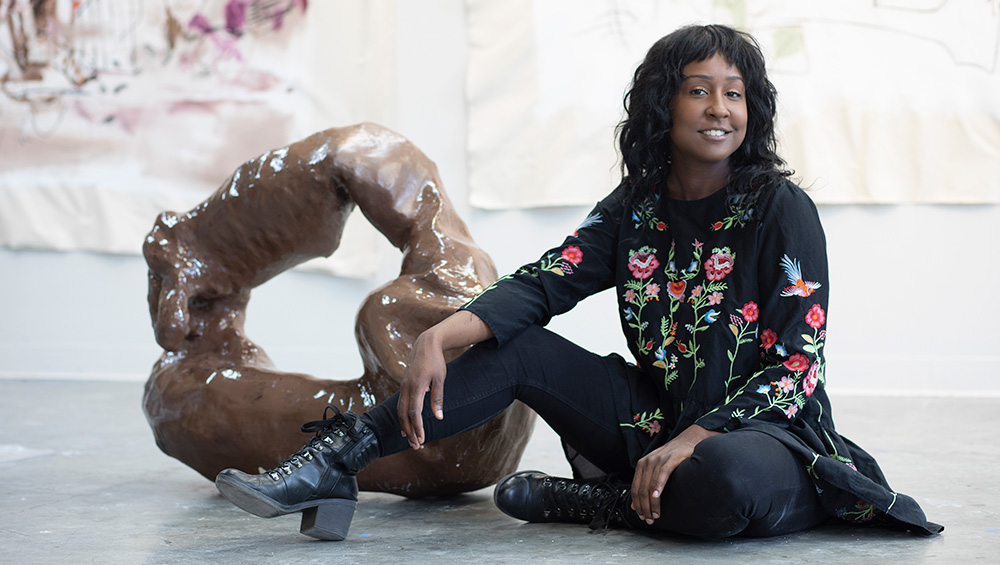
Carmen Neely. Photo: Lorraine Turi.
by ANNA McNAY
Carmen Neely (b1987, Charlotte, North Carolina) makes abstract, expressionistic paintings that translate poignant memories and experiences into gestures on canvas. In turn, these gestures frequently take on a life of their own, being sculpted into 3D forms, photographed and catalogued, and often, like so many other objects and imagined entities in the artist’s life, taking on names and unique personalities. Neely is a collector: of memories, of objects, of paraphernalia, of phrases. All of these things make their way on to and into her canvases, pushing the boundaries of painting, exploring its sense of timeless self-reflection, and ensuring there is a pure and open honesty in her own self-reflective work.
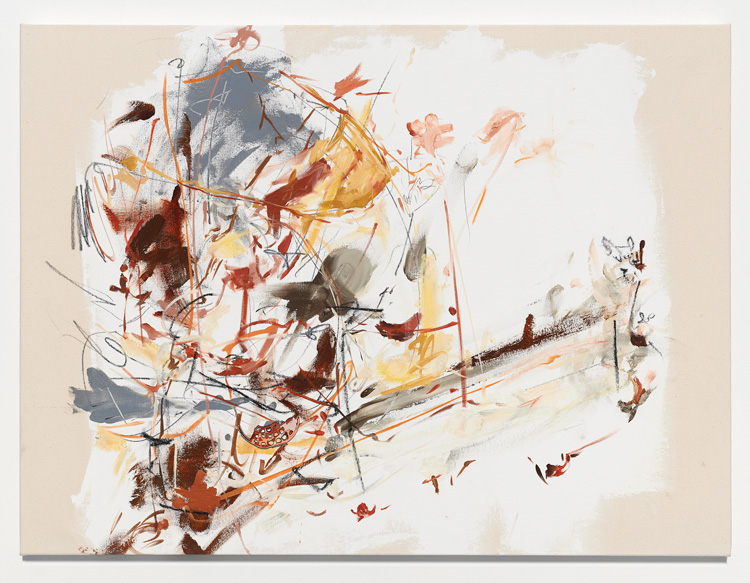
Carmen Neely. Breathe your own mask first, 2019. Oil on canvas, graphite, embroidery, 30 x 40 in (76.2 x 101.6 cm). Courtesy of the artist and Jane Lombard Gallery.
Studio International spoke to Neely by Skype about her practice, the role of collecting and (re)creating characters and identities, and how to be serious about one’s play.
Anna McNay: Perhaps we should start out with the fact that you are a collector. This seems to be the cornerstone of your practice. What do you collect and since when?
Carmen Neely: Yes, I think this really feeds into all the work I do. For some people, it might be difficult to see the relationship, especially if they’re just looking at one or two of my images, because they’re abstract painting predominantly, and so they might wonder how that connects to the process of collecting objects. One way to help people better understand the work is for them to know that I grew up as an only child, spending a lot of time alone, playing with objects, talking to inanimate things, creating characters out of toys and furniture, and personifying everything in the world around me. I lived in this space where anything could happen at any moment, and my parents completely indulged me in that behaviour and encouraged it. We have videos of me, out in public at restaurants or family events, and I’d just start talking to people who weren’t there, imagining … Also, I would save objects and they would become important identities to me. It would just be a doll’s hairbrush or something, and then I would build a series of dolls’ hairbrushes, which I grouped together, which meant something.
As I got older, that transferred into the way I would keep collections around people in my life. Things that related to my grandmother, for example – I would often take little trinkets from her house, so that one day I would have this little collection that would represent her and my memory of being with her in her home. I do that to this day, too, especially when I travel or visit friends. It sounds like I’m just going around stealing things but, the older I get, the more interesting I think it is to keep the objects that people overlook as savoured treasures. Receipts, or stuff that someone is otherwise going to throw away. I have a collection of food wrappers from travelling around Europe with ex-boyfriends. I think these things are interesting and tell a much more specific story than a souvenir that you might just have got at a gift shop, which anybody could have, and which is mass produced. This is the specific receipt from that particular day when we drank too much and tripped in the street – that feels more meaningful.
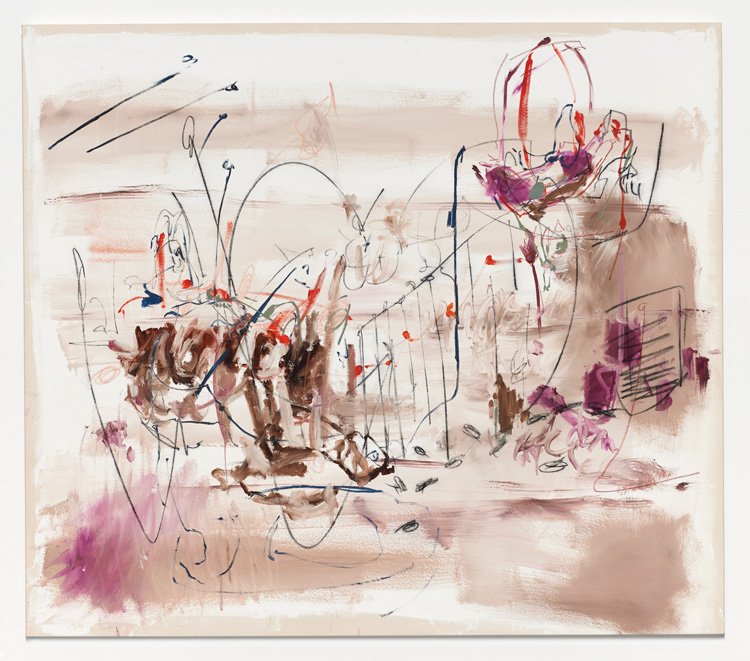
Carmen Neely. Heard quitting and seen dancing, 2019. Oil on canvas, graphite 64 x 56.25 in (162.56 x 142.88 cm). Courtesy of the artist and Jane Lombard Gallery.
I started playing around incorporating these things into my work. Maybe someone viewing it doesn’t know the weight that this seemingly random object carries, but, to me, it’s important to be honest and embed that truth into the work. As long as I continue to do that, something will ring true to the viewer as well, even if they can’t know all the details of the backstory.
AMc: When you say that you embed the object into the work, are you talking about making a painting of it, or are you literally talking about putting the object on to the canvas?
CN: Literally using the object in the canvas. Maybe now it’s more about painting, but some of my earlier works were a lot more object based. In my first solo show with Jane Lombard Gallery in 2017, It Makes It More So If You Say So, I was dealing with a lot of larger, physical objects. There was a buoy tied on to one panel with rope, and many plexiglass gestures, screwed on, glued on, and tied on to the surface. Two years later, I have just had a second exhibition with the gallery, Not a Tourist, and while the additions took different material forms, their presence was still a continuation of the same process of translating and all the steps that occur in between. Instead of large plastics, there are subtle lines of embroidery blending into paint, and enamel pins that extend the gestural language. I’m interested in referencing these things without using the actual object; I’m interested in the process of what is lost and gained in translation. It’s one form of translation for me to have this story I want to tell and then to communicate it through a painting. There’s a lot that gets lost in translation there. But then a lot grows out of the translation that allows people to engage with the story in a different way. Sometimes, I pull out individual gestures from a painting and find out what happens when they become 3D sculptures, or when they become drawings of the sculptures based on the painted gestures. All of these steps are really fascinating because they are a continuation of something that grows and changes and is a reflection of all these interventions. It’s the way storytelling works. My grandmother told me what happened to her when she was child, and I’ll tell my children and they’ll tell theirs. Everybody’s spin is added to the story. My version is based on my understanding of my grandmother. It’s understood through that lens. I think all these shifts in the object translations, or the gesture translations, are that kind of process, too.
AMc: Let’s take the example of In an Alternate Reality (2018), the work that is about to be included in a group exhibition of 25 artists, Front Burner: Highlights in Contemporary North Carolina Painting, looking at painting in the contemporary world of mass media. Can you talk a bit about the process and thoughts that went into its making?
CN: Yes, that’s a good example. It has some popsicles in it that are painted versions of real popsicles, but it also has a real faux flower crown in it. Both of those things specifically link to a relationship with one person and they are important markers of events that happened for us. Obviously, I couldn’t put actual popsicles in the painting because they wouldn’t last, but they became a connection, because everything else is so loose and gestural. They became a way to lead into the gestures from the object that’s sticking out from the canvas.
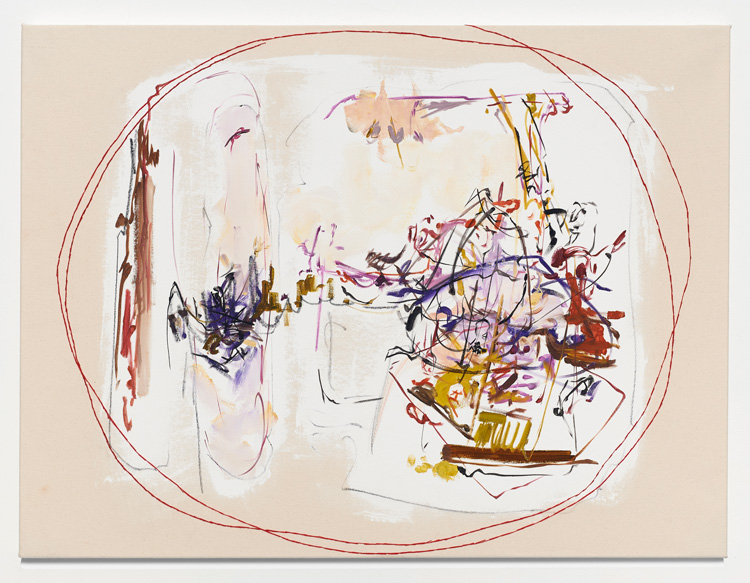
Carmen Neely. If you really love me, you'll talk to your therapist about me, 2019. Oil on canvas, embroidery, 30 x 40 in (76.2 x 101.6 cm). Courtesy of the artist and Jane Lombard Gallery.
AMc: You have just mentioned that you sometimes make sculptures of the objects, too.
CN: Yes. That’s usually the moment where it feels like I’m a kid again and these are my imaginary friends that have come to life that I need to name and identify. That’s usually the point where they become a character. I take gestures out of the movement in the painting.
AMc: So you’re not actually making casts of objects, you’re making 3D versions of painted gestures?
CN: Yes.
AMc: To be clear: you have made a painting, possibly drawing on 3D objects, and then you are looking at your painted 2D gestures and making 3D versions of them? It’s almost like the reverse process of painting an object …
CN: To me, even that’s not where the translation should end. I want the idea of these things to continue to live on, so they have to evolve and reflect this necessity for translating through different languages or vehicles or mediums. I take photographs – portraits – of the sculptures as well. Then I can digitally edit these and that’s how I was able to make embroidered patches of the original gestures, which then often get incorporated into a future work. And enamel pins as well. Not in In an Alternate Reality, but in a lot of the current work that I’m making. I’m just continually looking for new modes of replication and translation.
AMc: Where do the gestures themselves derive from? Are they a representation or translation of what you are feeling when you are making that work?
CN: I think a good way to describe what happens formally in the work is that I’m led by a specific memory, a conversation, or an event that’s happened. Everything that happens in that space, the interactions between gestures, the forms that evolve there abstractly, are a deconstruction and reconstruction of that memory. It is me channelling something that I have felt or that I’m feeling when thinking about that event or person. It’s like traditional expressionism or abstraction. But, afterwards, it’s a case of pulling out gestures and looking at all the signs and symbols as specific moments or phrases in the narrative. The titles are important because they are collected, too. I keep a running list in my phone and notebooks of things people say that stick with me. They range from ridiculous, silly things to really poignant beautiful things. I always start with the title and that directs what decisions I make in the painting.
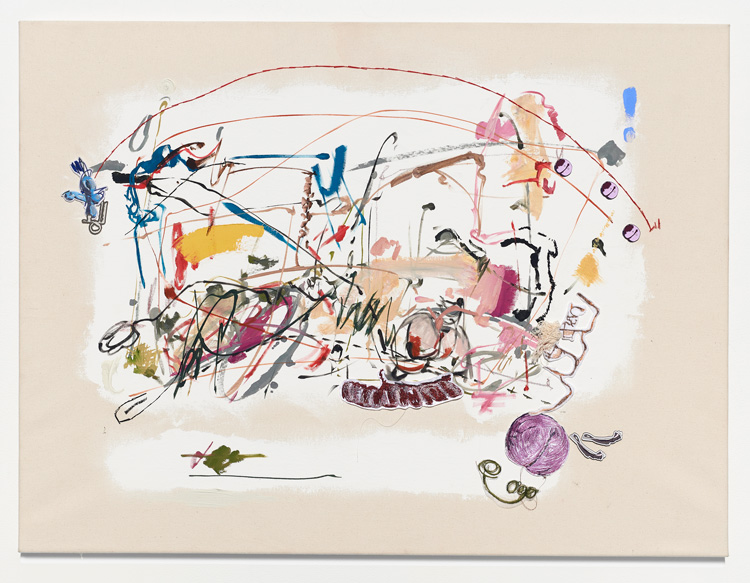
Carmen Neely. Maybe we're just drawing out bad diagrams, 2019. Oil and acrylic on canvas, enamel pin, embroidery, 30 x 40 in (76.2 x 101.6 cm). Courtesy of the artist and Jane Lombard Gallery.
AMc: Once you have created these gestures, if they are related to a specific person, will they only ever occur in another work that is related to that person, or might they then recur as semiotic symbols elsewhere?
CN: I think they have the flexibility to become part of new narratives. I realised how significant that sort of metaphor was when making a body of work about a breakup. It was very emotional for me – and dark. But there were all these beautiful symbols that I wanted to pull out, individual gestures. I wanted to appropriate them and use them in new works. I have all these representations of events that happened with this person that deeply affected me and now I want to move on. And I can. What happened with that person is something I’m going to carry with me, but the things that I learned from what’s represented in the works are going to inform new relationships, new conversations. It makes sense that they’re going to be part of new narratives and evolve into new meanings. But I like the idea of also being able to look back and trace the steps of where this came from.
AMc: So when you are setting out with a new work, you have the title and you have the memory or whatever experience you are working with, and you might have some objects, but you don’t have a specific image of how you want it to look when it is finished – or do you?
CN: No. At times there will be things that I know have to be included, but it’s usually not an idea of the whole image. With In an Alternate Reality, I knew that I was considering using the flower crown. I then had to wait and see if it would make sense visually. But I was thinking about it. I think the colour palette evolved out of that reference. And then I knew that I wanted the popsicles to be there somewhere. That’s all I knew. It’ll be things like that. Something will happen and I’ll think I have to include this really dirty green colour because that’s what the space was like, or things like that.
AMc: How do you go about attaching your various 3D objects to the canvas?
CN: When I’ve attached big 3D things, they’ve been epoxied on, or I would staple things or screw things in, and then the screw would become a part of the work, too. But now, everything is softer. The enamel pins are just pinned into the canvas and the patches are sewn on. It’s dictated by whatever material the object is. The flower crown is sewn into the canvas. There’s a metal opening that you can put into the fabric and the crown is sewn on through this.
AMc: How long, typically, does it take you to complete a work?
CN: It varies. I like to try to keep it fresh, not to get too far away from my memory of the event I’m referencing. I have had paintings where I lost it. I started and waited too long to finish and I just couldn’t remember enough, so it started to feel dishonest. I’ve had to scrap some works because of that. I also like to work on a lot at the same time. It can be a group of stories or memories that have happened around the same time in my life. Then they talk to each other, in a way.
.jpg)
Carmen Neely. In an Alternate Reality, 2018. Oil on canvas, plastic flower crown, 81 x 63 in (205.7 x 160 cm). Courtesy of the artist and Jane Lombard Gallery.
AMc: Do you do anything in particular to transport yourself back to that point in your life, to that moment? I mean, for example, do you play specific songs that you associate with that time, while you are working?
CN: I do work to a lot of music. When I was making the paintings that were sad for me about a relationship, it didn’t make sense to be dancing around to Beyoncé, so it would be softer music to stay in that space, for sure. But, really, it’s just about whether I am close enough to remember what it felt like when I was there, or when this thing happened, or when this thing was said.
AMc: You said at the beginning about collecting things to do with your grandmother. You have also talked before about this process of collecting and translating relating to your family history. In your artist statement, for example, you write about coming from a lineage of “sentimental black matriarchs who savoured their possessions for decades”, and you have also written: “’The mark’, revered and mythologised as the purest form of artistic intention in the art historical canon, becomes an act of subtle subversion with black female authorship.” How much of a role do you think race and gender plays in your work?
CN: I think there’s a large connection to being from the south and having a strong history of oral tradition and maintaining sentimental objects. Historically these were the only things that people had as ties to their ancestors. So those objects that are linked to people and their day-to-day lives become really important. Pots and pans handed down from your mother – you keep them.
Then, in terms of my identity being linked to the way in which I think about painting, I also think there’s something to be said for the way in which women of colour are constantly recommunicating themselves in different contexts. I see it a lot in academia, and I’m sure it happens in many other professions, too. Even within the art world, people want to be fitted into categories or want to place things in categories to understand them. There’s this need to label everything and everyone. I’ve had to deal with this throughout my whole life, so it’s significant because it affects the way I think about process and painting. I’m interested in the process of translation, but I think it’s so reflective of the fact that I am constantly living that day to day – re-explaining myself or performing aspects of my identity in certain ways for certain people. It’s like the painted gestures are doing that as well.
I also remember early on looking for examples of women of colour engaged in formal abstraction: no one could name any names and I didn’t know where to find them. I remember feeling like I knew that these people existed, but they just got lost somehow. So, how do I make sure that I don’t get lost? I can remake parts of myself and start again.
AMc: That actually leads nicely into the question I had about the influence of Jean Baudrillard on your practice, since you have quoted him on your website saying: “What you really collect is always yourself.” If you are talking about remaking yourself and asserting your identity, and you have just said that that, on one level, is what your work is doing, do you think it is also about accepting different parts of yourself, bringing them together, collecting them, and making a whole to present to the world?
CN: A whole? That’s interesting to think of it as making a whole. I feel like that will never be possible. It will never be possible to make enough to represent the fullness of one person. But, in a way, yes, I guess the process is attempting to get somewhere maybe close to that. I don’t think I would ever choose that phrasing, but it is a way of thinking about what all the remakes and translations are working towards. Nothing can be as simplistic as this gesture fitting here, and that one there, to make a whole. One gesture can live in the world as a reflection of its author and the narrative that it’s a part of. It can exist in the world in so many versions and iterations and still be related to itself or the original idea. Everything is multifaceted and, just because it is communicated through a different medium or in a slightly different context, it can still be true to itself.
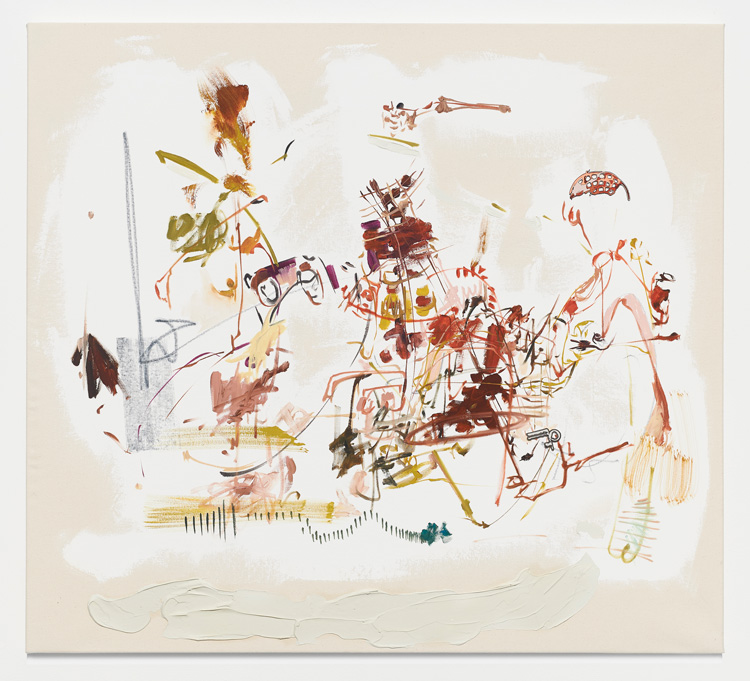
Carmen Neely. On the right track but on the wrong train, 2019. Oil on canvas, graphite, enamel pin, 36 x 40 in (91.44 x 101.6 cm). Courtesy of the artist and Jane Lombard Gallery.
AMc: I guess it would also always be a case of striving towards an unobtainable whole, since you are always changing yourself, so there is no fixed whole.
CN: Yes, right, that’s true. We’re all always more things. That’s another reason why I like the idea of trying to incorporate as many material formats as I can. I think I’ll be pursuing this for the rest of my life because it’s endless. For example, to use technology would also be a way of translating a gesture. To use something completely unrelated to paint, that can still be connected to painting, an extension of it, is reflective of the way we have to morph, and our forms of communication have to morph, in society. Everything is evolving so quickly. The way people share information is morphing all the time. This process of me translating myself in these gestures is just a reflection of that.
AMc: You keep referencing painting. Do you consider yourself to be a painter, despite the fact that you work in and incorporate other media, or do you think of yourself more as an artist per se?
CN: I do feel like I have a strong identity as a painter, but I also feel like if you had asked me the same question a couple of months ago, or if you asked me next year, I might give a different answer. I know today I’ve got this very strong sense of being a painter. But I think it’s OK for that to be flexible and change and evolve as well. I’m comfortable in that space of flux.
AMc: At what point did you decide to become a painter or artist? You didn’t start out as a fine art major, although that was what you ended up as.
CN: I was all over the place when I was an undergraduate. I remember I started off at school and I changed my major every semester. Most people now at liberal arts schools tell you to take all these general education requirements in the beginning and figure out who you are. But, every semester, I was like: “No, I know who I am, I’m going to take all these psychology classes, I don’t need general education!” I did that for four semesters and didn’t really make any progress towards graduation. I went through a serious emotional crisis and started having a lot of anxiety issues. This is a really common story among artists and a lot of other people in higher education now. But I remember taking one of those professional career tests and it told me that I was meant to be a photographer. I was like: “What?! Waa!” This was not something I had ever considered. But I took a photography class as an elective and I became obsessed with it. The person teaching the class was a graduate student, and that was the first time I ever knew people went to college to pursue art. I had had no examples of this in my life. It made me realise that I was interested in the pursuit of learning. I was trying to understand things. But then I would get to a point where I had all this information and not the right outlet to express or deal with it. That really changed my life.
When I was younger, I used to do a lot of creative things, but they were never named as art. My mom was an elementary schoolteacher and, when I had projects for school as a kid, she would ask me what I wanted to make. Sometimes they’d be really elaborate projects. And she would say: “OK, we’re going to go to the crafts store, we’re going to get whatever you need.” She totally fostered my imagination in the best way. She would go all out and get me whatever materials and help me make a plan for constructing things.
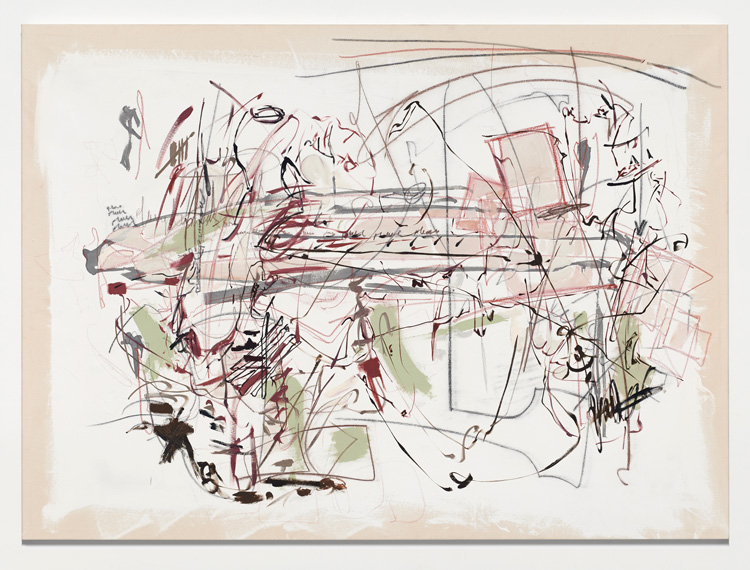
Carmen Neely. This tattoo is gonna save my life, 2019. Oil on canvas, graphite, 70 x 51.25 in (177.8 x 130.18 cm). Courtesy of the artist and Jane Lombard Gallery.
AMc: That is the beauty of not labelling things. You just do it and enjoy it and it is just like play, in a way. Not that I am saying what you do now is just play …
CN: Well, in a lot of ways, it is. For me, having that component is an important part of my practice – to be open enough for things to happen in a space of free exploration and silliness and to know that that doesn’t make me any less serious an artist. I went through a phase where I felt I needed to prove myself and be taken seriously and, for that, I felt I couldn’t be naming inanimate objects or talking about them like they were people, even though it’s something instinctual for me. I felt I had to shut off those parts of my personality. But now I realise that if I let myself access that side of myself and try to really understand it in a thoughtful way, then it is really meaningful and doesn’t devalue anything. It makes my work honest, which is the most important thing for me.
AMc: Honesty?
CN: Yes, honesty in my work.
AMc: You have this really playful side, but then you also back yourself up with a lot of heavy philosophy and theory. We’ve already mentioned Baudrillard …
CN: It’s true. It’s in my nature also to want to overanalyse everything. I want to fully understand all the ways I can look at something – upside down, inside out. But, for some reason, I was afraid initially to do that. Somebody told me when I was in grad school to be serious about my play. So, my play takes the approach where I just let things happen, I let myself be, I let myself make, and, instead of first trying to dictate what has to be in the work, I reverse that process and make the thing that I feel I need to make, and then understand why I’m making those choices. That space is really rich with information and connected to so many things outside myself.
AMc: Your works derive ultimately out of very personal and intimate memories and conversations. You have just mentioned connections to things outside yourself. What do you hope viewers, who won’t know these backgrounds, will get from your work? There is always something universal, I guess, and something incredibly personal that each person will bring with them and be able to recognise in your work.
CN: Absolutely. Even though my wanting to collect things is connected to my personal and familial background, it also has a lot to do with the era I grew up in, and the culture of the time. Do you remember Lisa Frank? I don’t know if that was a thing where you are, but Lisa Frank was a brand of school supplies for kids. Everything was collectible, brightly coloured, cute animals. There was this whole thing of kids collecting eraser sets just to have them, not to use them. They had unicorns and sheep and pigs. There were notepads and pencils. Everybody had brightly coloured Lisa Frank stuff. It’s like Hello Kitty, a version of that kind of thing. Being a kid in the late 80s/early 90s, there was just a lot of stuff to consume. That also feeds this desire I had to want to save everything – stuff that I didn’t really need, but I just wanted to have because all my friends had. My collecting absolutely ties to consumer culture as well. I grew up in this time of economic flourish in the US, in an upper-middle-class family.
AMc: I wonder what it is like today, because there is so much more digital stuff, rather than actual physical objects.
CN: Interesting. I know that there must be versions of what we had. Kids today have their own cartoon characters and stuff. But I’m not around as many small children as I am early college-age kids. And you’re right, for them it’s all about the digital. I just had a 45-minute discussion with one of my classes about meme culture, thinking about it in terms of Walter Benjamin’s The Work of Art in the Age of Mechanical Reproduction. Somebody could write that same thing now about social media. There are just these short snippets, 15-second long memes, but they all know them and have them saved on their phones. Maybe it’s evolved into that.
AMc: That is then completely about creating yourself, or the image of yourself that you want to project, and then recreating and recreating it.
CN: Yes, right.
AMc: Finally, as we have mentioned, you are about to be included in the group exhibition Front Burner, looking at painting in the contemporary world of mass media. You will also be taking part in a panel discussion, considering what the special qualities inherent to painting might be that make it persevere and remain “on the front burner”. Can you give us a little preview into your thoughts on this matter? What are the special qualities inherent to painting?
CN: I think painting has constantly existed in the state of self-reflection, and what makes the medium itself timeless is artists using it as a tool to question how it can be reflective of our current world, through interactions with technology and other media. That’s why the show is really fresh, because there is a lot of interdisciplinary questioning and exploration – and not just by artists attaching objects to their canvases!
• In an Alternate Reality by Carmen Neely will be included in the group show Front Burner: Highlights in Contemporary North Carolina Painting, at the North Carolina Museum of Art, from 7 March to 26 July 2020